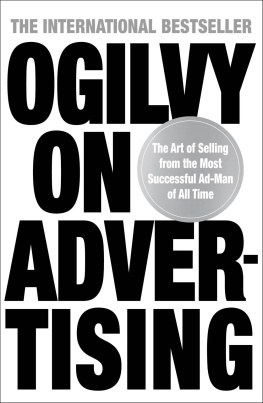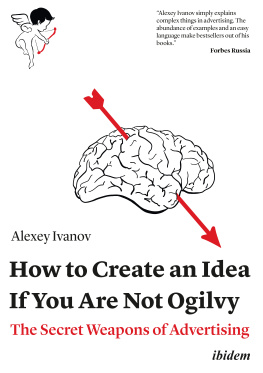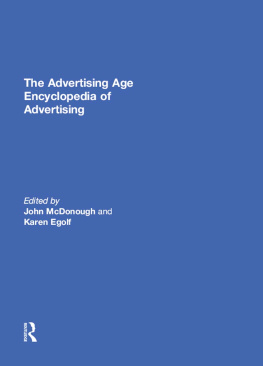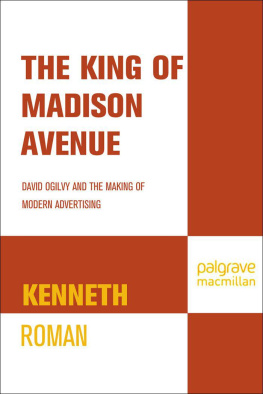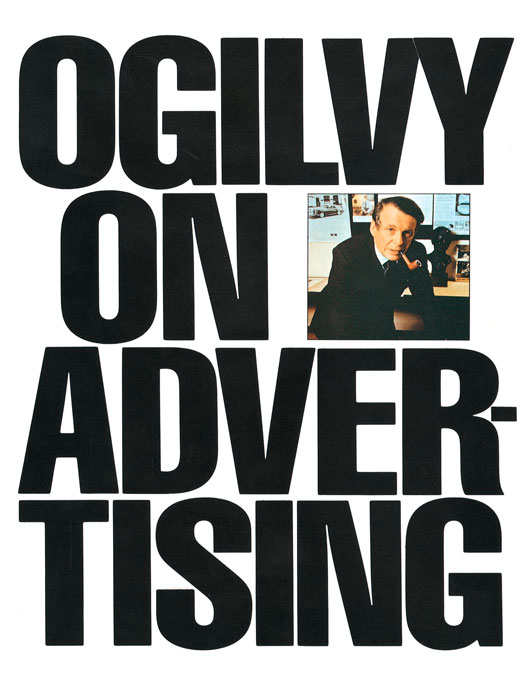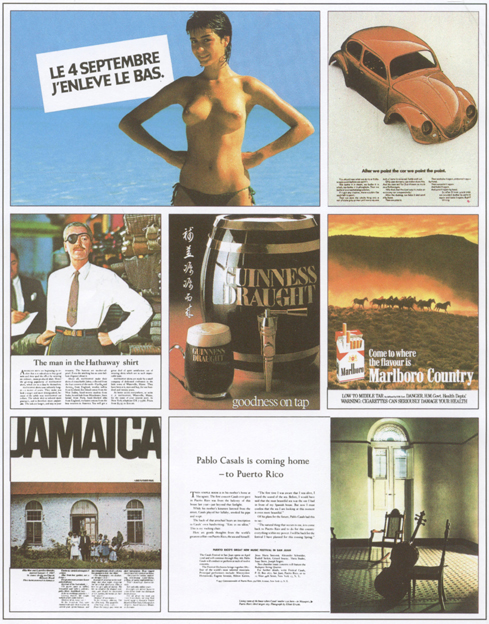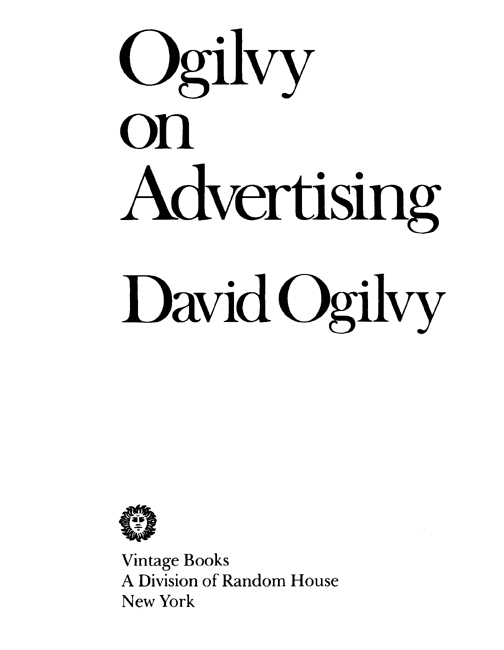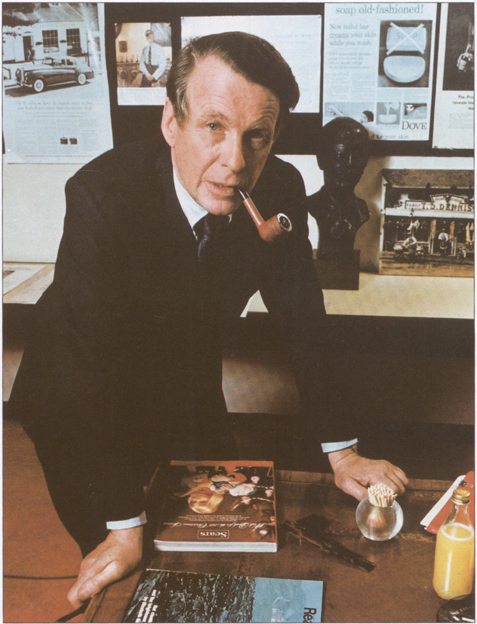First Vintage Books Edition, March 1985
Text copyright 1983 by David Ogilvy
Compilation copyright 1983 by Multimedia Books Ltd. (Now Prion Books Ltd.)
All rights reserved under International and Pan-American Copyright Conventions.
Published in the United States by Random House LLC, New York. Originally published in the United Kingdom by Pan Books Ltd. and Orbis Publishing Ltd. and in the United States by Crown Publishers, Inc., in 1983.
A Penguin Random House Company
Library of Congress Cataloging in Publication Data
Ogilvy, David. 1911
Ogilvy on advertising.
Bibliography: p.
Includes index.
I. Advertising. I. Title.
[HF5823.36 1985] 659.1 84-40525
ISBN 0-394-72903-X (pbk.)
eBook ISBN: 978-0-8041-7005-5
v3.1
Cover design by James K. Davis
Contents
1
Overture
Let us march against Philip
I do not regard advertising as entertainment or an art form, but as a medium of information. When I write an advertisement, I dont want you to tell me that you find it creative. I want you to find it so interesting that you buy the product. When Aeschines spoke, they said, How well he speaks. But when Demosthenes spoke, they said, Let us march against Philip.
In my Confessions of an Advertising Man, published in 1963, I told the story of how Ogilvy & Mather came into existence, and set forth the principles on which our early success had been based. What was then little more than a creative boutique in New York has since become one of the four biggest advertising agencies in the world, with 140 offices in 40 countries. Our principles seem to work.
But I am now so old that a French magazine lists me as the only survivor among a group of men who, they aver, contributed to the Industrial Revolution alongside Adam Smith, Edison, Karl Marx, Rockefeller, Ford and Keynes. Does old age disqualify me from writing about advertising in todays world? Or could it be that perspective helps a man to separate the eternal verities of advertising from its passing fads?
When I set up shop on Madison Avenue in 1949, I assumed that advertising would undergo several major changes before I retired. So far, there has been only one change that can be called major: television has emerged as the most potent medium for selling most products.
Yes, there have been other changes and I shall describe them, but their significance has been exaggerated by pundits in search of trendy labels. For example, the concept of brand images, which I popularized in 1953, was not really new; Claude Hopkins had described it 20 years before. The so-called Creative Revolution, usually ascribed to Bill Bernbach and myself in the fifties, could equally well have been ascribed to N. W. Ayer and Young & Rubicam in the thirties.
Meanwhile, most of the advertising techniques which worked when I wrote Confessions of an Advertising Man still work today. Consumers still buy products whose advertising promises them value for money, beauty, nutrition, relief from suffering, social status and so on. All over the world.
In saying this, I run the risk of being denounced by the idiots who hold that any advertising technique which has been in use for more than two years is ipso facto obsolete. They excoriate slice-of-life commercials, demonstrations and talking heads, turning a blind eye to the The New Yorker, I was the hero of this coterie, but when I graduated to advertising in mass media and wrote a book which extolled the value of research, I became its devil. I comfort myself with the reflection that I have sold more merchandise than all of them put together.
I am sometimes attacked for imposing rules. Nothing could be further from the truth. I hate rules. All I do is report on how consumers react to different stimuli. I may say to a copywriter, Research shows that commercials with celebrities are below average in persuading people to buy products. Are you sure you want to use a celebrity? Call that a rule? Or I may say to an art director, Research suggests that if you set the copy in black type on a white background, more people will read it than if you set it in white type on a black background. A hint, perhaps, but scarcely a rule.
In 18th-century England, a family of obstetricians built a huge practice by delivering babies with a lower rate of infant and maternal mortality than their competitors. They had a secret and guarded it jealously, until an inquisitive medical student climbed onto the roof of their delivering room, looked through the skylight and saw the forceps they had invented. The secret was out, to the benefit of all obstetricians and their patients. Todays obstetricians do not keep their discoveries secret, they publish them. I am grateful to my partners for allowing me to publish mine. But I should add that the occasional opinions expressed in this book do not necessarily reflect the collegial opinions of the agency which employs me.
This is not a book for readers who think they already know all there is to be known about advertising. It is for young hopefuls and veterans who are still in search of ways to improve their batting average at the cash register.
I write only about aspects of advertising I know from my own experience. That is why this book contains nothing about media, cable television or advertising in Japan.
If you think it is a lousy book, you should have seen it before my partner Joel Raphaelson did his best to de-louse it. Bless you, Joel.

Testy, a grumbler, inclined to praise the way of the world when he was a boy, to play the critic and to be a censor of the new generation.
2
How to produce advertising that sells
P retend you started work this morning in my agency, and that you have dropped by my office to ask for advice. I will start with some generalities about how to go about your work. In later chapters I will give you more specific advice on producing advertisements for magazines, newspapers, television and radio. I ask you to forgive me for oversimplifying some complicated subjects, and for the dogmatism of my style the dogmatism of brevity. We are both in a hurry.
The first thing I have to say is that you may not realize the magnitude of difference between one advertisement and another. Says John Caples, the doyen of direct response copywriters:
I have seen one advertisement actually sell not twice as much, not three times as much, but 19 times as much as another. Both advertisements occupied the same space. Both were run in the same publication. Both had photographic illustrations. Both had carefully written copy. The difference was that one used the right appeal and the other used the wrong appeal.



